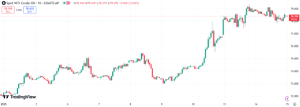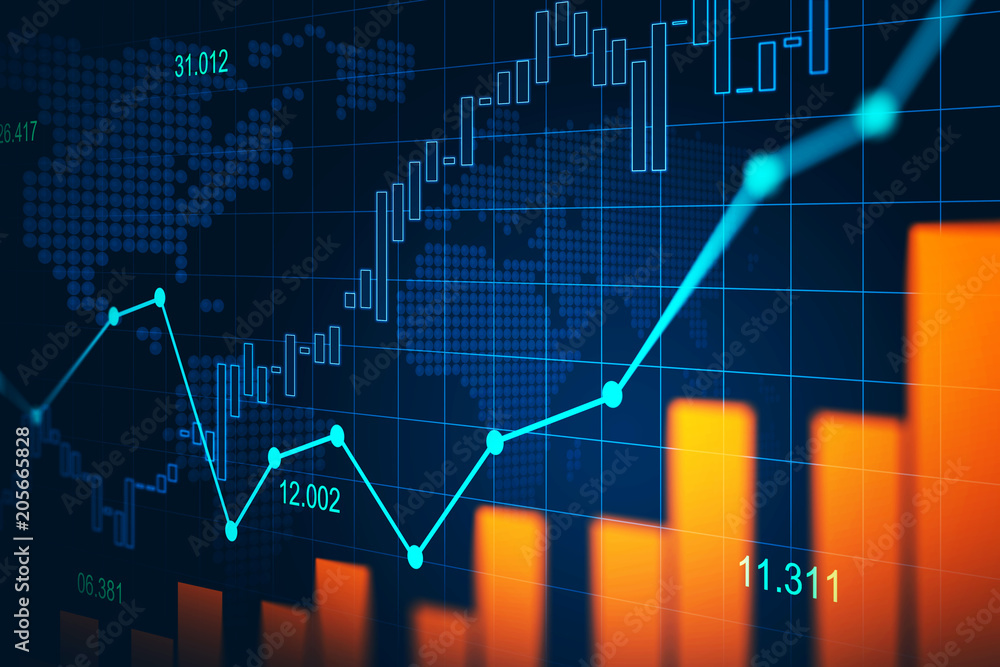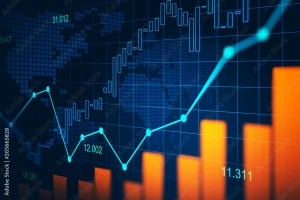市场资讯及洞察
.jpg)
量子计算:和平年代的“核武器”,以及赛道上的7大玩家
提到“核武器”,大家想到的是改变战争格局的终极威慑力;而在没有硝烟的和平年代,量子计算正成为新的“战略王牌”。
它不靠爆炸力,而是靠指数级算力重塑科技、经济、安全的底层逻辑。谁先掌握它,谁就能在新药研发、信息安全、新能源等领域抢占先机。
这是一场没有硝烟的“量子军备竞赛”,而谷歌、IONQ等公司,就是这场战争的主角。
一、为什么说量子计算是和平时期的“核武器”?
普通电脑像“单线程快递员”,一次只送一件包裹;
量子计算靠“量子比特分身术”,能同时处理海量信息——10个量子比特就能同时计算1024种状态。
这种差距,不是“快一点”,而是“维度不同”:就像骑自行车去追火箭。
它能干的事堪称“颠覆级”:
· 破解银行、互联网加密系统(别人算几百年,它几小时搞定)
· 模拟分子结构加速药物研发(几年缩成几个月)
· 优化交通、金融、能源系统(让全球效率更高)
所以,谁掌握量子计算,谁就能制定未来的技术规则和安全标准。这份话语权,正如核武器之于国家安全一样。
二、赛道上的7大玩家:谁在领跑?
1. 谷歌(GOOGL)——超导路线的“火箭选手”
谷歌是量子计算的顶流。
它的超导芯片“Willow”已经做到105个量子比特,速度比全球最快超算还快1.3万倍。
它能计算分子结构,加速新能源电池和抗癌药研发。
谷歌放话:5年内实现实用化应用。
短板也有:超导量子比特太“娇气”,要放在比南极还冷几百倍的环境里,目前还只能处理特定任务。但作为科技巨头,谷歌的资源和研发速度,让它仍是最有可能先造出“量子核武”的玩家。
2. IONQ——离子阱路线的“精密工匠”
IONQ用激光“抓住”带电原子作为量子比特,精度极高、错误率低。
它靠32个量子比特就宣称实现“量子优越性”,比谷歌还早一步。
现在专攻“量子纠错”,让运算更稳定,是迈向实用的关键。
缺点是难以扩展,加一个比特像往积木塔上叠块砖,容易影响整体。
但在科研模拟、精密计算等领域,它的“精准”优势明显,有望后来居上。
3. 霍尼韦尔(HON)——幕后“装备大佬”
霍尼韦尔虽然不出风头,但它的子公司Quantinuum是离子阱路线的中坚力量。
更重要的是,霍尼韦尔的激光器、制冷系统、测控设备,是全球量子实验室的标配。
它是量子领域的“军工厂”,不造火箭,但造发动机。
在未来的产业链中,它是所有玩家都离不开的“幕后功臣”。
4. QUBT——专做“量子安全”的锁匠
QUBT不做量子计算机,而是做防量子破解的安全加密。
它利用量子技术生成不可预测的密钥,给数据上“防量子锁”。
银行、政府机构已经在用它的产品。
未来量子计算能破解传统加密,而QUBT的锁正是抵御“量子黑客”的盾牌。
算是最贴近普通人生活、最早能变现的应用方向。
5. QBTS——“软件+硬件”的小众探索者
QBTS采用特殊的核磁共振技术,在常温环境下也能运行,不用极冷设备。
目前算力较弱,主要帮企业做物流规划、路线优化等小型任务。
虽然不是“超级计算怪兽”,但胜在灵活低成本,可能在特定场景率先落地。
6. Rigetti(RGTI)——被巨头甩开的追赶者
RGTI走超导路线,推出过80比特设备,但进展放缓。
现在主攻“量子云平台”,让企业租算力做实验。
只是面对谷歌、IBM的强势,它的技术差距越来越大,市场声音也逐渐变弱。
7. Laser Photonics(LAES)——“量子副业”的蹭热股
LAES主业是激光设备,量子只是“副业”。
偶尔宣布要搞“光量子技术”,但没有实际芯片或数据。
目前更像是“站在量子赛道边上的观察员”,未来潜力有待验证。
三、我们应该关注什么?
不能以为这只是科研人员的游戏。量子计算未来影响的是你我的生活:新药更快上市,电动车续航更高,网络支付更安全,物流更智能。
如果要关注投资方向或应用落地:
谷歌:技术最强、速度最快,五年内可能看到实用成果;
IONQ:纠错领先,科研和精密行业潜力大;
QUBT:防量子黑客的“安全护盾”,最贴近现实场景。
四、结语:量子“军备竞赛”才刚开始
量子计算不是“更快的电脑”,而是和平年代的核武器。它决定未来科技的主导权,也重塑国家竞争格局。
现在的玩家,有的快、有的稳、有的专,但真正的胜者,取决于谁能先跨过“纠错”和“可扩展”这两道坎。
十年后,你用的药、开的车、上的网,背后可能都有量子计算的力量。这场“无声的军备竞赛”,正在改变人类的未来。


热门话题
今天跟大家聊聊关于价格波动性很强,最近表现不错的原油。影响原油价格的因素很多,我们今天就来说几个比较主要的,然后一起看一看怎么通过这些因素判断原油价格的未来趋势。

原油和其他大宗商品的逻辑是一样的,价格变化首先需要考虑的就是供给关系,目前OPEC+依旧是影响原油供给端的核心力量,OPEC+的减产计划给原油价格的上升提供了支撑,此外沙特和俄罗斯还采取了额外的减产措施,进一步推动了原油价格的上涨。但与此同时,美国页岩油的弹性供应始终是市场的重要变数,尽管美国钻井平台数量减少至527座(较去年同期下降15%),但本土页岩油行业近年来技术进步飞快,这也让美国能迅速在价格上升时恢复产量。这种灵活性制约了OPEC+控制油价的能力,在一定程度上抵消了OPEC+减产带来的原油价格上升影响,但是全球范围内对于原油价格影响最大的供给端依旧是OPEC+,所以OPEC+减产还是可以给原油带来一个价格上涨的趋势。

讨论完供给端后接下来就是需求端。需求端的主要构成就是一些原油的进口国,比如中国作为全球最大的原油进口国,最近的经济活动的复苏信号给市场带来了积极的影响,在2024年,中国日均原油进口量达到1150万桶,同比增长了6%。然而,欧美市场的需求增长就没有这么可观。欧洲的高能源成本和美国的高利率环境,都在不同程度上抑制了原油消费,并且新能源转型的步伐也在逐步改变传统能源的需求格局。2024年,全球电动车销量突破1100万辆,同比增长35%,这直接削弱了汽油和柴油的需求增长。这一趋势尽管在短期内对油价的直接冲击有限,但从长期看,能源转型将不可避免地压缩原油市场的需求增长空间。
我们总说原油的价格波动性很强,因为不仅仅供需关系会影响原油价格,政治和地缘因素也会给原油价格带来波动。
举一个政治因素的例子,特朗普重新执政后,计划对加拿大的大宗商品进口征收25%的关税,这其中就包括了原油,这个消息周一一经发出,加拿大43家能源企业组成的指数就下跌了1.4%。并且这一政策除了限制加拿大能源企业的盈利能力之外,也会带来更深远的影响。比如可能会潜在影响供应链分裂导致运输成本上升,加拿大作为美国最大的原油进口来源,2023年向美国出口原油365万桶/日,占美国进口总量的52%。一旦关税实施,加拿大原油可能面临更高的运输成本,影响北美能源市场的价格平衡。而在这一背景下,加拿大可能寻求扩大对亚洲市场的出口,影响到全球竞争格局。但全球和美国的油价并没有受此影响,反而由于运输进口成本上升和特朗普本身作为“亲石油派”等等原因继续表现出了上涨趋势。

除了政治因素,地缘因素对原油市场的影响也很明显。我们所熟知的中东地区,巴以和伊朗的冲突很有可能会威胁到原油出口的运输,而乌克兰和俄罗斯战争也让俄罗斯的原油出口能力面临更大挑战,加剧全球供应的不确定性,导致油价进一步上涨,这点通过观察整个2024年源于市场的表现就可以看出。
所以总结来说,不同因素会造成原油价格不同方向的趋势。今天我们提到过的可能造成原油价格上涨的原因包括了:特朗普上任后落实了对加拿大包括原油在内的大宗商品征收关税;原油进口国的需求量增大。而反之以下这些因素有可能造成原油价格推翻上涨趋势开始下跌:大力推动新能源应用发展的政策出台;OPEC+停止减产计划,供给上升;以及现在巴以冲突进入了最后谈判阶段,如果顺利停战,对中东地区的原油出口压力变小,原油价格也会开始下降。
免责声明:GO Markets 分析师或外部发言人提供的信息基于其独立分析或个人经验。所表达的观点或交易风格仅代表其个人;并不代表 GO Markets 的观点或立场。联系方式:墨尔本 03 8658 0603悉尼 02 9188 0418中国地区(中文) 400 120 8537中国地区(英文) +248 4 671 903作者:Yoyo Ma | GO Markets 墨尔本中文部


Welcome to 2025, a year that will be shaped by macro thematic events that were put in place at the end of 2024. Why we need to prioritise thematic analysis is that if we look at 2023 and 2024 indices and FX markets that were tied to the thematics of those two years outperformed peers and similar tools. Considering the S&P 500 returned a whopping 25 percent in 2024, starting the new year around the event that will shape the trading world is prudent.
So what will be the big thematics of 2025? Here are the five themes shaping the year ahead, each refined to align with evolving market dynamics: 1. The nationalisation of globalism Tricky title yes, but we are going to see a return to nationalistic policies from all walks of government.
This theme is likely to make a strong return in 2025 after pausing from about mid 2023. It will be driven by shifting global trade particularly the US and China and policy priorities of populist governments that are popping up all over the world. The push pull of nationalism versus globalism has rapidly swung back to nationalism since COVID.
Policymakers are consistently banging the drum that reducing reliance on globalised supply chains in favour of localised production and economic security. Just take a look at the policy ‘Future made in Australia’. This is a policy that is picking winners directly targeting manufacturing and a technology space that is already saturated with global supply.
The question we as traders and investors have to ask is will national policy supporting inefficient industry win out over global supply into the future? Theory would suggest not investment however follows the money and governments are piling money in. Again that's not to say it's right, it's just the flow.
With the return of a Trump administration to the White House not only is nationalistic policies going to be front and centre for investment tariffs and trade impacts will also be a major theme for 2025 and beyond. The playbook here is to review Trump 1.0 and look at the impacts on trade from 2017 to 2020. More on that below.
What is clear is the current populist shift to nationalism in global supply chains marks the biggest swing in trade systems since the 1960s. What we need to realise as investors is which multinationals and trading firms can adjust to the new reality and which will face the challenges that they are unable to survive. Identifying these changes will be key to investing going forward. 2.
China sandbagging One of the fastest developing thematics of 2025 is signs that Beijing it's starting to sandbag itself against future incoming tariffs from the West, specifically the US. Already we're seeing changes to liquidity ratios, policy and local government that haven't been in place since 2017 and 18. We're also starting to see policies around employment, aged care, and other social services that have not been enacted or tweaked in over half a decade.
Couple this with signs of increased infrastructure spending changes to manufacturing orders and a shift in direction to internal purchases. Shows Beijing really does mean business And is preparing to fight fire with fire. Most notably that ‘fire’ power is the tweaks that's happening to the renminbi.
The depreciation that has been allowed by the Peoples Bank of China (PBoC) shows very clearly that if tariffs are to be placed on Chinese exports the appearance at the import docks will be one of negligent, even better off positioning in price. It is a very, very savvy way of countering arbitrary cost increases from its biggest market, that of the US. How Washington responds to this change is likely to be just less dramatic.
Be prepared for a full blown currency trade war over the next four years as Beijing and Washington trade economic barbs. The winners and losers are already starting to present, case in point is the impact and slide in price of the Aussie dollar (AUD). Currently sitting at a 5 year low to start 2025 against the US dollar and having seen a 10 per cent decline against the JPY, and 8 per cent decline against the CHF, EUR and even a 5 per cent decline against the GBP.
The AUD’s China proxy thematic is well and truly kicking and the Aussie will be a key part of the China sandbagging thematic trade of 2025. 3. Meaningful living Do not underestimate the change in social structures around ‘meaningful living’. With aging populations across the developed world more and more societies are shifting to pursue healthier and more meaningful lives.
This is the rise of online and AI driven programming health treatments, new age drug consumption and a concentration on preventative medicine and health products. Meaningful living is moving the dial in policy, economies, and businesses. You only have to look at Apple's investment in its fitness app or the rise and rise of wearables.
Increase content on social media and the impact that AI is now having on medical and health related industries. On this point look to healthcare, particularly AI-driven advancements and obesity treatments to continue to be the stand out areas. Then there will be the changes to consumption behaviours, nutrition and affordable foods, ‘core value’ items over mass consumption as well as demand for more sustainable consumption practices.
The advantage of the meaningful living thematic is that it will likely be fairly isolated to the issues that will present from thematic 1 and 2. You will also be fairly insulated from changes of things like inflation, interest rates and politics. 4. Energy Thirst The thirst for energy supply coupled with decarbonisation is going to be a thematic not just of 2025 but over the next decade.
What will be different in 2025 is a short- and long-term supply change. Once again, nationalism will play a part here – the Trump administration has made it a cornerstone of its re-election pitch that oil will be front and centre in the US’s energy supply. However at the same time Elon Musk’s presence makes the outlook for battery storage and Electric Vehicles (EVs) also very interesting.
Longer term – energy will also face the ultimate question of 100 per cent renewables, a hybrid model that includes fossil fuels and/or a model that involves yellow cake. Uranium is facing an interesting period, the demand from China, France, the US and the like for nuclear energy is growing by the year. We are also now seeing nations that have never entertained nuclear having a debate on it as well (Australia is case in point).
Thus from a trade and investment point of view – we need to consider three points here: Supply - who are the suppliers that will benefit short term who benefits long term? And are there players that will benefit over the entire period? Demand – As stated in thematic 1,2 and 3 energy demand is only going to increase and if we include thematic 5 – not only will demand increase it could move almost exponentially.
Delivery – what form of apparatus is needed to deliver the energy nations need? That means everything from renewables to nuclear, micro units (household solar) to macro units (power plants). As well as energy storage, carbon capture and grid optimisation. 5.
AI the third digital revolution It’s been two years since ChatGPT’s debut – and in those 24 months more value has been created than in the 65 years from 1945 to 2010 and we are still early in AI’s widespread adoption. AI is being called the third digital revolution after the invention of the computer and the internet. The difference in 2025 from 23 and 24 is we are moving from “infrastructure” and “enablers” to applications.
Those programs that will drive efficiency and market leadership. Already the fight is on to be the “it” provider here as the likes of Alphabet, Meta, Microsoft and Amazon continue to redefine their individual offering. The trends here that will matter in 2025 are things like enterprise adoption of AI, which firms are adopting AI and its positive impacts?
Rapid increases in AI capabilities, surprising even the most optimistic expectations and how fast can it move? Expanded profit opportunities, reducing debates over AI’s return on investment. The faster we can understand the pace of these changes the more investors can capitalise on AI’s transformative potential.
In short, with these five thematics as our basis for 2025, it will be an exciting and transformative year.


For traders, the motivation to explore additional technical indicators often stems from a desire to enhance trading results and refine their existing system. With the abundance of information available about technical indicators, it can be tempting to incorporate new tools into your strategy. However, as the decision-maker in your trading journey, it is crucial to approach this process with a structured mindset.
The first step is to ask yourself a fundamental question: “Is it the right time to explore the use of another indicator?” This article outlines four critical questions you should consider before introducing new technical indicators into your trading system. 1) Am I Fully Actioning my Existing System? The primary motivation for adding a new indicator is often to improve the results of your current trading system. However, such improvements can only be measured if you have a well-defined system and are consistently trading it as designed.
A comprehensive system should at least include rules for entry, exit, and position sizing. Key Considerations: Are you faithfully following your current trading plan? Are you journaling your trades to track adherence and outcomes?
For many traders, the root issue lies in either an incomplete system or inconsistent execution. Honest self-assessment, backed by evidence from a trading journal, will help identify gaps in your current approach. Addressing these gaps should be your priority before adding another layer of complexity with a new indicator.
Action Steps: Review your trading journal to ensure you are consistently following your existing plan. Focus on refining your discipline and execution rather than prematurely seeking additional tools. 2) Is Adding Another Indicator the Most Impactful Change I Can Make Right Now to my trading? Improving your trading outcomes involves prioritizing actions that offer the highest potential for positive change.
While adding an indicator may seem appealing, there are other critical areas to address first: Trading Plan and Discipline: Ensure your existing plan is robust and that you are adhering to it consistently. Journaling: Regularly document your trades to provide a foundation for evaluating performance. Knowledge Development: Deepen your understanding of the indicators you already use.
Recognize what they reveal about market conditions and their limitations. Expanding your knowledge not only helps you maximize the effectiveness of your current tools but also enables you to make informed decisions about integrating new ones. In many cases, these priorities may outweigh the benefits of adding another indicator at this stage.
Action Steps: Evaluate whether enhancing your plan, discipline, or learning offers more immediate value than exploring new indicators. Commit time to mastering your existing tools before seeking additional complexity. 3) Do I Have Clarity on What any New Indicator Should Achieve? Before introducing a new indicator, you must clearly define its intended purpose.
Start by identifying whether your focus is on improving entries, exits, or another specific aspect of your trading system. Once you’ve pinpointed the objective, consider whether adjustments to your current indicators might achieve the same goal. Example: If you use a 10-period EMA as an exit signal but find it too sensitive to market noise, you could test a simple adjustment, such as switching to a 20-period EMA, before adding a new indicator.
Action Steps: Identify the specific gap in your system that a new indicator would address. Evaluate whether tweaking the parameters of your current tools could achieve the desired improvement. Test adjustments thoroughly before implementation. 4) Do I Have a Formal Testing Process in place for an evaluation of a New Indicator?
Introducing a new indicator requires a structured testing process to evaluate its impact on your trading outcomes. This process ensures that any changes to your system are based on evidence, not speculation. Testing Framework: Back-Test: Analyze past trades to determine how the new indicator would have influenced outcomes.
The goal is to justify the need for a forward test. Forward Test: Use a demo account to test the indicator in real-time market conditions. Maintain all other aspects of your trading plan to isolate the indicator’s impact.
Trading Plan Integration: If testing yields positive results, document how the indicator will be used within your trading plan. Be specific about its role and under what conditions it will be applied. Review Period: Set a timeline (e.g., three months) to assess the indicator’s performance and its contribution to your overall strategy.
Action Steps: Develop a clear and disciplined testing process. Specify the number of trades you consider sufficient for evaluating the indicator’s effectiveness. Regularly review and refine your approach based on test results.
Conclusion Adding new indicators to your trading system can undoubtedly enhance outcomes, but only when approached strategically. Before making changes, take the time to ask yourself these four critical questions: Am I fully utilizing my existing system? Is adding another indicator the most impactful change I can make right now?
Do I have clarity on what the new indicator should achieve? Do I have a formal testing process in place? By addressing these questions, you can ensure that any decision to incorporate a new indicator is well-informed and aligned with your broader trading goals.
Thoughtful preparation and disciplined execution will ultimately yield the best results for your trading journey.


热门话题
延续上期深度解析,剖析未来潜力赛道在上篇文章中,我们聚焦了宏观驱动因素和行业变革的总体趋势。本期内容将更进一步,通过数据与估值的精要分析,深入剖析高成长行业背后的逻辑,同时探讨潜在的风险与应对策略,为您全景呈现未来5-10年内的市场机遇与挑战。三、数据与估值简要分析若公司目前市盈率(PE)相对合理,盈利(E)能保持年复合增速 30%,则在 5-8 年后,有机会出现数倍市值提升(也需考虑估值变化与市场情绪)。科技型公司需要观察其研发费用率(R&D/Sales)、专利申请数量和质量。高研发投入往往带来较大的不确定性,但也是未来爆发的重要驱动力。市场渗透率与 TAM(Total Addressable Market,潜在市场规模)如果公司的产品或服务针对的是一个规模极大的新兴市场,其市占率每提升1 个百分点都可能带来显著的业绩增长。如全球半导体、绿色能源、互联网用户等,在未来5~10 年中仍会继续扩张。针对中美科技博弈、新兴市场基础设施、疫情后经济复苏等因素,要进行情景分析。若面临出口管制或政策不利限制,企业的成长路径会被延缓甚至中断。四、风险提示与总结行业与技术风险:科技类公司需长期投入研发,但新产品未必一定成功;生物医药企业面临临床试验不及预期或安全性问题;清洁能源公司易受原材料价格与补贴政策影响。宏观与地缘政治风险:中美等大国博弈、贸易限制、汇率波动、金融环境收紧等因素,都可能打断原有的成长逻辑。市场估值与资金面波动:有些高成长公司在前期已累积较高估值,若市场流动性趋紧或投资风格切换,股价可能短期大幅回调。公司治理与执行力:能否有效执行战略、把握市场节奏,最终关乎企业能否真正兑现成长预期;管理层失误、内控问题、企业丑闻等皆会打击投资者信心。

最后提醒:追求高回报往往意味着选择高弹性、高风险的标的;并非所有投资者都适合长期持有此类高波动资产。投资者应结合自身风险偏好与资金流动性需求,进行资产组合配置;高成长板块可作为组合的“进攻”部分,另可搭配防御性资产(如国债或消费蓝筹)平衡波动。此外,若经济环境或行业竞争格局发生重大变化,请及时动态评估投资逻辑的可持续性。结语:放眼全球,未来5~10 年将是科技突破、能源革新与人口结构重塑的关键时期。在半导体与AI、清洁能源与储能、生物医药、以及新兴市场互联网消费等领域,确实存在潜在的高回报机会。但要实现高回报,必须准确识别行业趋势与企业核心竞争力,并在市场震荡中保持理性与耐心。本篇所提及的企业如NVIDIA、ASML、Tesla、Vestas、Moderna、CRISPR Therapeutics、Sea Limited等,或许在各自赛道具备长期向好的逻辑,但其成长路径仍可能面临各种风险与挑战,投资者需结合具体财务数据、估值水平及宏观政策进行深入研究后再做判断。免责声明:GO Markets 分析师或外部发言人提供的信息基于其独立分析或个人经验。所表达的观点或交易风格仅代表其个人;并不代表 GO Markets 的观点或立场。联系方式:墨尔本 03 8658 0603悉尼 02 9188 0418中国地区(中文) 400 120 8537中国地区(英文) +248 4 671 903作者:Jacky Wang | GO Markets 亚洲投研部主管


热门话题
过去2个月,澳元和美元以及人民币的汇率以几乎斜45度的角度一路往下跌。要不是我告诉你澳元是目前发达国家里少数还没有降息的国家,你一定以为澳洲至少应该降息3,4次了吧。事实上,相比澳元,反而是美元倒是真实并且大步的连续降息。那为何高利息的澳元能跌出5年的新低呢?100个原因总结到一句话就是:大家担心未来一段时间,铁矿石卖不动了。其实一直以来,澳洲一直在努力尝试拜托对于资源出口的依赖,经过20年的努力,现在终于从主要依靠矿产,变成了一半靠矿产,一半靠移民的经济体。和我之前说过10遍一样,今天再重复一次,和其他发达经济体相比,澳洲的独门秘籍就是通过控制移民数量,来调整经济增长。我们都听过一句广告词:渴了喝红牛,累了更要喝红牛。对于澳洲来说,就替换成:经济慢了放移民,经济衰退更要放移民。移民,就是澳洲的红牛。下面一张图给大家看一下当年2023年疫情结束以后,澳洲为了拉动经济,一下次放了多少人进来:

虽然说2020-2022年因为疫情的原因导致新增移民大减,但是这2023年一下次放超过50万人,是不是也太多了?就算是2024年,实际新增移民也超过40万,着意味着短期内澳洲需要承受多100万人口的压力。我们都知道,澳洲看上去很大,其实80%的人口就住在最大的5个城市里,而大部分移民又都会选择这5个城市,甚至只会选择前3个城市。这就直接导致澳洲几个大城市几乎在短时间内新增了大几十万人口对于生活资源的需求。为啥澳洲物价突然增加这么高,怎么都压不下去?这不废话么,接近100万新增人口产生的硬刚需,是不论短期内加多少利息,都无法降息的生活需求。所以这也是为什么,其他发达国家可以在短时间内压低通胀,但是澳洲不行。因为澳洲为了避免经济衰退,硬生生在2年内引入了接近100万的成年劳动力人口,虽然这些新增人口成功的帮助澳洲避免了经济陷入衰退,但是也使得当澳洲想控制通胀时,会更难,需要的时间更长。鱼和熊掌不可兼得。所以我们也就别抱怨了。欧洲美国当年2020-2022比澳洲惨太多了,所以现在别人物价压下去,我们在澳洲也别羡慕。众生平等。

根据以上的背景,我预计短期内澳元和美元的汇率都不会特别好。因为对于铁矿石以及原材料的需求量短时间不会大幅提高。那既然澳元将会在在较长一段时间内和美元保持弱势,这是好事还是坏事呢?按照我的习惯还是一句话切入要害:对澳洲国家利益来说是好事,对百姓生活来说是坏事。为啥呢?简单说,汇率低,有利于国家的出口(以美元结算,换回来的钱更多)。那相反,对于进口的商品来说,就需要更多的本地货币去换。大到汽车家电,汽油钢材,小到手机电脑这些百姓生活中的必需品。抛去商家打折的因素,他们的进口成本如果以澳元来计算,那一定是比1年前更贵。而不论是汽油,生活用品以及白色家电,都会统计在通胀计算中。因此过低的澳元和保持高数量的新增移民是澳洲迟迟无法控制通胀最大的原因。而这些,很大程度上,其实联邦政府短期内是无法改变的。因为大量新增移民,都是过去2,3年内提交的申请。而就算现在马上改变政策,也有非常大的一个延迟效应,需要至少6个月后才能体现在经济上。

而在今年2025年澳洲大选开始之前,目前的在野党已经提出了两个重磅经济政策:1.永久削减25%的移民数量。以及2. 2年内禁止外国人买房。第一个政策看上去很夸张,其实是基于2023,或2024的数字,这两年本来移民数就比2020年之前高了至少50%,所以减少25%,也只是仅仅回到2019年的水平,没啥问题。而后者,禁止外国人买房,也是一个雷声大,雨点小的政策。毕竟目前外国人接近12%的印花税加上目前还有10-15%的卖方强制截留政策已经吓跑了大部分潜在买家。所以这两个政策看似非常惊悚,其实减少移民的确可以在长期减少对通胀的压力,但是更多情况下,这两个政策是为了迎合本地选民而创建的。要真正快速的压低通胀,又不影响经济太多,还要增加选票,是不可能的。我们知道本质上,控制通胀就是需要让经济冷却,所以如果你一边要抓经济,一边又要压低物价,这从根本上就会产生大量的矛盾性政策。免责声明:GO Markets 分析师或外部发言人提供的信息基于其独立分析或个人经验。所表达的观点或交易风格仅代表其个人;并不代表 GO Markets 的观点或立场。联系方式:墨尔本 03 8658 0603悉尼 02 9188 0418中国地区(中文) 400 120 8537中国地区(英文) +248 4 671 903作者:Mike Huang | GO Markets 销售总监


热门话题
周五美国12月非农数据远超预期,在前值下修的情况下,最新数据达到25.6万,加上失业率超预期回落至4.1%,大幅降低了美联储降息预期,甚至有机构开始放言2025美联储无需降息。三大股指应声大跌,标普周五收跌1.54%,周跌1.94%,尝试重回周MA10失败;纳指收跌1.63%,周跌2.34%下破周MA10;道指跌1.63%,周跌1.86%与十周均线渐行渐远;罗素2000小盘股指数跌超2.2%。加上一月财报季开启,美股整体有较大几率持续回调。国际宏观消息面近期也是加剧恐慌利空股市。特朗普每天都在放话博眼球,距离1月20号入驻白宫已经十分接近了,接下去的关税政策大改令市场恐慌,其不惜将美国带入紧急经济状态而提速关税政策落地的言论更令市场担忧全球通胀恶性反弹。另外美国面临的债务上限问题依然没有解决,耶伦等着国会通过新的债务上限法案迟迟没有下文,也令市场充满了不安。还有加州山火目前造成了美国较大的经济损失,短期也将令保险行业和公共事业相关企业蒙受重大损失。目前能源价格持续大涨,油气价格因俄乌进一步相互压制能源供应链而被持续抬高。黄金美元近期双双保持上冲,国际资本避险情绪大幅提高。

美股板块方面周五大多数下跌,AI板块仅META和台积电等极少数保持不跌,META掌舵人扎克伯格站队和拜登划清界限,接收采访时道出企业改革方案和抨击政府干预言论自由,台积电12月营收大幅增长,本周等待财报检验。英伟达跌3%,苹果跌2.41%,特斯拉微跌。核电板块尽管有国际铀价持续反弹助力,但大环境暴跌令美铀继续下行,核技术股普跌,CEG逆市大涨超过25%,以165亿美元收购Calpine,令其电力供应产业链更为完善,两大电力股的合并令CEG在电力缺口加剧的环境中更具竞争力。上周CES大会黄仁勋发言扑灭了量子计算狂热潮,但助推了机器人概念,周五机器人概念也能逆市收涨。今天澳股大概率股指也会大幅下跌,但能源和贵金属的强势对澳股有一定利好。只不过在美元持续强势的碾压下,澳元一直无力抵抗,目前已经跌破0.615平台。美元直冲110仅年新高,金价逼近2700短期目标位,很快将兑现预期重回2700大关。原油更是冲破了近几个月的上限,美油周五大涨后冲上76大关。恐慌指数如期继续上行,在本周CPI预期反弹较大的前提下,恐慌将进一步上行,股指可以继续看空,本周美国金融行业的密集财报将成为能否稳定住美股的关键。免责声明:GO Markets 分析师或外部发言人提供的信息基于其独立分析或个人经验。所表达的观点或交易风格仅代表其个人;并不代表 GO Markets 的观点或立场。联系方式:墨尔本 03 8658 0603悉尼 02 9188 0418中国地区(中文) 400 120 8537中国地区(英文) +248 4 671 903作者:Xavier Zhang | GO Markets 高级分析师

